Just to be clear of my point, I admit generalizing all of them, but I don't call any of them trash, they do what they are supposed to do, a social media facade but not the official outlet. If I must put scores on them, being official is 100, being trash is below 30, most social medias are between 90 and 30.You can't generalize all of them just because 81 acc was trash.
You are using an out of date browser. It may not display this or other websites correctly.
You should upgrade or use an alternative browser.
You should upgrade or use an alternative browser.
Chinese Engine Development
- Thread starter jackbh
- Start date
Sorry for digging up an old discussion, but nonsense espoused this confidently just needs to be put in its place.
I ran those screen grabs through a translator and your "source" does not say what you claim it does. The fact of the matter is, the latest WS-10 versions that have been around for about 5 years have comparable thrust (~14t) and turbine inlet temperature (~1750K) to the 117S that has been around for more than 10 years. IIRC the service life & MTBO numbers mentioned by RadicalDisconnect actually apply to the new WS-10s rather than the WS-10A, which would've been significantly worse than the AL-31F. After all, it got temporarily displaced from both the J-11A and J-10A/B airframes for that very reason, and only very recently regained the more critical single-engine application.
Fuel consumption is a more complex issue, given similar TIT it's driven primarily by BPR which is slightly higher in the WS-10 family than the AL-31F family (~0.8 vs. ~0.6). This makes for somewhat lower dry (static) SFC in the Chinese engine but higher afterburning SFC, and at speed the difference in dry consumption isn't going to be worth mentioning either. This is just an engine cycle vs. flight performance choice where the Russians - fractionally - favoured high-Mach performance (air-to-air biased Su-35S) and the Chinese range (strike biased J-16). In terms of cycle parameters and architecture, these engine families are actually closer than late-model F100s & F110s - we are really talking nuances!
Now we come to the final measure and the biggest difference between them - engine life and MTBO. As we've previously established, the TIT in both is very similar, yet the Russians (in an engine that entered service earlier) are achieving double the service life. Considering how steep the TIT vs. life gradient is, that's not a small difference, though of course the WS-10 has achieved a level where it is acceptable and can feasibly substitute Russian imports.
And if we cast a wider net, let's see when the Chinese can claim to have an airliner engine in commercial service that has an on-wing time (i.e. time between maintenance too intrusive for it to remain installed on the aircraft) of >10000hours and a life of more than 40000hours, like the good old PS-90A...
All you are proving here is that you have not the faintest clue of how these smoke emissions arise in modern engines. In steady-state operation, soot formed in the combustion chamber is consumed by secondary air before being exhausted through the turbine and nozzle. The one exception (which does happen to be Russian, but no longer applies to the most recent models) is the RD-33, which has a compact combustion chamber that proved physically too short for this to occur. During throttle transients however, where additional fuel is dumped into the engine to cause it to spool up, the air-fuel ratio is temporarily enriched to the point that soot/smoke can escape. This includes ALL engines, explicitly also the WS-10 and even 5th generation models like the F135 or EJ200!
Case in point (that took me about 2 minutes to find):
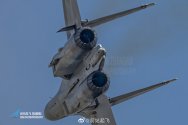
so you want source. fine
during Zhuhai Air show 2021. deputy chief designer of J-20 officially acknowledged, WS-10C performance exceed all Russian machines we have used before. in terms of thrust , inlet turbine temperature , fuel consumption and service life.
I ran those screen grabs through a translator and your "source" does not say what you claim it does. The fact of the matter is, the latest WS-10 versions that have been around for about 5 years have comparable thrust (~14t) and turbine inlet temperature (~1750K) to the 117S that has been around for more than 10 years. IIRC the service life & MTBO numbers mentioned by RadicalDisconnect actually apply to the new WS-10s rather than the WS-10A, which would've been significantly worse than the AL-31F. After all, it got temporarily displaced from both the J-11A and J-10A/B airframes for that very reason, and only very recently regained the more critical single-engine application.
Fuel consumption is a more complex issue, given similar TIT it's driven primarily by BPR which is slightly higher in the WS-10 family than the AL-31F family (~0.8 vs. ~0.6). This makes for somewhat lower dry (static) SFC in the Chinese engine but higher afterburning SFC, and at speed the difference in dry consumption isn't going to be worth mentioning either. This is just an engine cycle vs. flight performance choice where the Russians - fractionally - favoured high-Mach performance (air-to-air biased Su-35S) and the Chinese range (strike biased J-16). In terms of cycle parameters and architecture, these engine families are actually closer than late-model F100s & F110s - we are really talking nuances!
Now we come to the final measure and the biggest difference between them - engine life and MTBO. As we've previously established, the TIT in both is very similar, yet the Russians (in an engine that entered service earlier) are achieving double the service life. Considering how steep the TIT vs. life gradient is, that's not a small difference, though of course the WS-10 has achieved a level where it is acceptable and can feasibly substitute Russian imports.
And if we cast a wider net, let's see when the Chinese can claim to have an airliner engine in commercial service that has an on-wing time (i.e. time between maintenance too intrusive for it to remain installed on the aircraft) of >10000hours and a life of more than 40000hours, like the good old PS-90A...
Russians are still unable to solve the chronic problem of black smoke. this is latest SU-57 during test flight powered by AL-41 engine. heavy fuel consumption machine with low service life. look at the black smoke
not even a single Chinese engine emit black smoke. it means chamber and core machine of Chinese engines are far better than any Russian engine.
All you are proving here is that you have not the faintest clue of how these smoke emissions arise in modern engines. In steady-state operation, soot formed in the combustion chamber is consumed by secondary air before being exhausted through the turbine and nozzle. The one exception (which does happen to be Russian, but no longer applies to the most recent models) is the RD-33, which has a compact combustion chamber that proved physically too short for this to occur. During throttle transients however, where additional fuel is dumped into the engine to cause it to spool up, the air-fuel ratio is temporarily enriched to the point that soot/smoke can escape. This includes ALL engines, explicitly also the WS-10 and even 5th generation models like the F135 or EJ200!
Case in point (that took me about 2 minutes to find):

Last edited:
by78
General
cannot tolerate a person, who is actually exaggerating Russian tech in 2022. LAMOOO
so you want source. fine
during Zhuhai Air show 2021. deputy chief designer of J-20 officially acknowledged, WS-10C performance exceed all Russian machines we have used before. in terms of thrust , inlet turbine temperature , fuel consumption and service life.
View attachment 100526View attachment 100528
how Chinese surpassed Russians despite very late start .. coz they learned from west. civil high tech industries development and progress have always an impact on your defense sector. USSR/Russia both failed in this sector. Russia still struggling in precision manufacturing.
Russians are still unable to solve the chronic problem of black smoke. this is latest SU-57 during test flight powered by AL-41 engine. heavy fuel consumption machine with low service life. look at the black smoke
not even a single Chinese engine emit black smoke. it means chamber and core machine of Chinese engines are far better than any Russian engine.
WS-15 is very close to enter in small scale production stage. this engine will put China into elite group of aero engine makers globally.
Can we get some corroboration from well-read people here whether posts like these are accurate or even close to accurate? Or at least if this particular poster has been known to be reliable enough that we can take his word for granted?
I don't know who we can rely on and who is just exaggerating or even just making stuff up. It would be great if there was a page which should moderator approved individuals who are considered to be at the top in terms of objectivity, reliability, so on.
Sorry for digging up an old discussion, but nonsense espoused this confidently just needs to be put in its place.
I ran those screen grabs through a translator and your "source" does not say what you claim it does. The fact of the matter is, the latest WS-10 versions that have been around for about 5 years have comparable thrust (~14t) and turbine inlet temperature (~1750K) to the 117S that has been around for more than 10 years. IIRC the service life & MTBO numbers mentioned by RadicalDisconnect actually apply to the new WS-10s rather than the WS-10A, which would've been significantly worse than the AL-31F. After all, it got temporarily displaced from both the J-11A and J-10A/B airframes for that very reason, and only very recently regained the more critical single-engine application.
Fuel consumption is a more complex issue, given similar TIT it's driven primarily by BPR which is slightly higher in the WS-10 family than the AL-31F family (~0.8 vs. ~0.6). This makes for somewhat lower dry (static) SFC in the Chinese engine but higher afterburning SFC, and at speed the difference in dry consumption isn't going to be worth mentioning either. This is just an engine cycle vs. flight performance choice where the Russians - fractionally - favoured high-Mach performance (air-to-air biased Su-35S) and the Chinese range (strike biased J-16). In terms of cycle parameters and architecture, these engine families are actually closer than late-model F100s & F110s - we are really talking nuances!
Now we come to the final measure and the biggest difference between them - engine life and MTBO. As we've previously established, the TIT in both is very similar, yet the Russians (in an engine that entered service earlier) are achieving double the service life. Considering how steep the TIT vs. life gradient is, that's not a small difference, though of course the WS-10 has achieved a level where it is acceptable and can feasibly substitute Russian imports.
And if we cast a wider net, let's see when the Chinese can claim to have an airliner engine in commercial service that has an on-wing time (i.e. time between maintenance too intrusive for it to remain installed on the aircraft) of >10000hours and a life of more than 40000hours, like the good old PS-90A...
All you are proving here is that you have not the faintest clue of how these smoke emissions arise in modern engines. In steady-state operation, soot formed in the combustion chamber is consumed by secondary air before being exhausted through the turbine and nozzle. The one exception (which does happen to be Russian, but no longer applies to the most recent models) is the RD-33, which has a compact combustion chamber that proved physically too short for this to occur. During throttle transients however, where additional fuel is dumped into the engine to cause it to spool up, the air-fuel ratio is temporarily enriched to the point that soot/smoke can escape. This includes ALL engines, explicitly also the WS-10 and even 5th generation models like the F135 or EJ200!
Case in point (that took me about 2 minutes to find):
View attachment 102867
I saw that clip, he did mention ws-10c exceeded the al31++ in all categories.
Also, capability to make commercial turbofan engine is not an indicator of ability to produce their own high thrust turbofan engine for jet fighter, i.e France.
Here's a video of what the deputy designer of J-20 said at Zhuhai Airshow:
Here's an English summary of what he said:
1) Engines are the heart of an aircraft, and engine performance (e.g. thrust) is crucial to the overall performance of a fighter aircraft.
2) The J-20 is now equipped with domestic engines, which is a milestone.
3) The design of an aircraft is inseparable from engine development. The two processes are intertwined. The airframe and engines must be matched and optimized for each other. Our design process takes into consideration future engine upgrades.
4) The overall flight performance of the J-20 with domestic engines is "superior and not inferior" to the J-20 powered by Russian engines.
The deputy designer was very careful with his words. What he actually said was that the overall flight performance of the J-20 airframe, when powered by domestic engines –– after engine/airframe performance matching and optimization –– is at least equal to or better than the J-20 airframe powered by Russian engines.
In other words, he never directly compared the WS-10C and Russian engines, much less saying that "WS-10C performance exceed all Russian machines we have used before", which by the way would include the Izdeliye-117s that come with China's Su-35s –– a dubious claim at best.
Our flagship military threads have a higher bar for accuracy and low tolerance for exaggeration and mis-representation. Please report only what's actually said, don't stretch, and don't be sensational.
Last edited:
I saw that clip, he did mention ws-10c exceeded the al31++ in all categories.
Also, capability to make commercial turbofan engine is not an indicator of ability to produce their own high thrust turbofan engine for jet fighter, i.e France.
True,the version of al31 used on J-20 isn't Russian's top-notch engine,Russia has better engine than that.
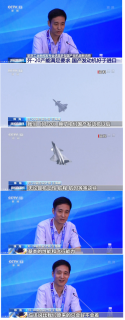
Interesting facts:
1)It seems to be general consensus that WS-10c variant milked out extra juice from WS-10B by sacrificing the engine life-span, yet it still has better performance( most likely thrust), fuel consumption and lifespan than AL-31, speak volume about how ridiculously low it was to begin with.
2) As for AL-41, educated guess can be made that it will be heavier (due to tvc), and most likely shorter lifespan as well due to it being Russian made, and lower thrust (loss due to tvc) and TWR (extra weight and thrust loss). But hey, it has TVC, so that's the added bonus.
It can't be helped that conjecture somehow comes with confirmation bias, but i hope it's not lopsided against the chinese. So i balanced things out, and the outcome is still in favour of WS-10c compared to AL-31 and AL-41.
Running those screen caps through the translator would seem (the translation isn't the most intelligible) to corroborate what by78 already stated, notably the fact that comments refer to performance at the airframe level.
Interesting facts:
1)It seems to be ...
2) As for AL-41, educated guess...
It can't be helped that conjecture...
Do you not see the contradiction here?
Especially since, at least with the AL-41F, there is absolutely no need whatsoever to rely on guesses (educated or less so) and conjecture - virtually all relevant info on it is in the public domain. Including a claimed weight penalty for the Saturn-proprietary TVC nozzle design, if you dig deep: 50 kg per engine, which isn't a lot (~3%). There's also a total engine weight somewhere at 1604kg to the basic AL-31F's 1520kg and since it has various other tweaks (larger fan diameter etc.), 50kg for TVC sounds entirely plausible. There's further plenty of stuff, including drawings, on the Saturn TVC nozzle that, if you know the source of thrust loss in other TVC designs, allows you to figure out that this solution avoids it neatly. Clue: deviations from circular cross section.
And if we do want to make an *educated* guess, the slightly higher bypass ratio of the WS-10 would tend to make it a bit heavier, all else equal. Lower specific thrust, meaning less thrust per unit air mass flow and therefore larger turbomachinery for the same thrust. Not that at 0.8 vs. 0.6 BPR you'd expect to see a much of a difference, frankly it could easily get lost in the noise (TVC etc.), but still, that's the sound first principles conjecture in this case.
Regarding life, again a fairly sane guess can be made from the fact that the early WS-10 was too unreliable for even the twin engine J-11 application, and that the AL-31F was the replacement. It was only with the latest variants that the WS-10 could be used in the single-engine J-10, and then the AL-41F has longer life & MTBO than the AL-31FN that was previously fitted. So even if it is now better than the original Russian engine (as would be the case if the figures mentioned apply to the WS-10C) it could still be worse than the AL-41F. And, of course, the latter had already been around for more than 5 years by the time the transition was finally able to be made on the J-10...
All of this in no way detracts from the fact that China has closed the gap considerably over the past 20 years. It's now roughly 5 to 10 years behind Russia and in an industry where the product development cycle takes 15 to 20 years, that is not a lot at all. They are now less than a generation apart, i.e. China is introducing engines of the same sort of sophistication with merely a few years delay. Already, its portfolio is on the cusp of eclipsing Russia's for breadth if not quality. And once the economic fall out of the Ukraine invasion starts to hit home in the coming years, the remaining Russian lead likely stands to dwindle faster than it otherwise would have.
Found this patent by 606th on 2D ejector TVC nozzle. In the diagram, 2 is the inner tube (convergence), 2 is the outer tube (divergence). In between is the channel of air bypassing the engine. The petals are connected to the outer tube.
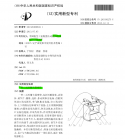
Remember this CG some years ago in Zhuhai show? See the the air gap that the arrow pointed at. Also the nozzle rotates without changing shape.
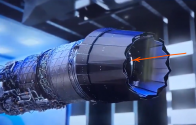
in 2022 Zhuhai show we see this one. A 3D TVC nozzle that rotates without changing shape.
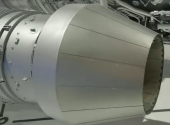
Initially I pointed out that this is different from AVEN/J-10TVC (Convergence Divergence nozzle based). @Blitzo suggested that the model may be poorly constructed. After finding the patent, it seems to me that TVC can be made from ejector nozzle, either 2D or 3D. In an ejector nozzle, petals of the expansion (outer) section can be mounted on a rigid ring instead of connected to the convergence petals unlike a CD nozzle. The whole outer section can remain circular when rotating.
Also worth to note that, the 2D TVC in 2022 may not be an ejector nozzle as the patent. For an ejector nozzle, the moving outer petals must be mounted on a tube which is connected to the fuselage instead of the engine pipe. The photo I have shows that the petals are connected to the engine directly.

Remember this CG some years ago in Zhuhai show? See the the air gap that the arrow pointed at. Also the nozzle rotates without changing shape.

in 2022 Zhuhai show we see this one. A 3D TVC nozzle that rotates without changing shape.

Initially I pointed out that this is different from AVEN/J-10TVC (Convergence Divergence nozzle based). @Blitzo suggested that the model may be poorly constructed. After finding the patent, it seems to me that TVC can be made from ejector nozzle, either 2D or 3D. In an ejector nozzle, petals of the expansion (outer) section can be mounted on a rigid ring instead of connected to the convergence petals unlike a CD nozzle. The whole outer section can remain circular when rotating.
Also worth to note that, the 2D TVC in 2022 may not be an ejector nozzle as the patent. For an ejector nozzle, the moving outer petals must be mounted on a tube which is connected to the fuselage instead of the engine pipe. The photo I have shows that the petals are connected to the engine directly.
correctionFound this patent by 606th on 2D ejector TVC nozzle. In the diagram, 2 is the inner tube (convergence), 2 is the outer tube (divergence). In between is the channel of air bypassing the engine. The petals are connected to the outer tube.
View attachment 103011
Remember this CG some years ago in Zhuhai show? See the the air gap that the arrow pointed at. Also the nozzle rotates without changing shape.
View attachment 103013
in 2022 Zhuhai show we see this one. A 3D TVC nozzle that rotates without changing shape.
View attachment 103014
Initially I pointed out that this is different from AVEN/J-10TVC (Convergence Divergence nozzle based). @Blitzo suggested that the model may be poorly constructed. After finding the patent, it seems to me that TVC can be made from ejector nozzle, either 2D or 3D. In an ejector nozzle, petals of the expansion (outer) section can be mounted on a rigid ring instead of connected to the convergence petals unlike a CD nozzle. The whole outer section can remain circular when rotating.
Also worth to note that, the 2D TVC in 2022 may not be an ejector nozzle as the patent. For an ejector nozzle, the moving outer petals must be mounted on a tube which is connected to the fuselage instead of the engine pipe. The photo I have shows that the petals are connected to the engine directly.
In the diagram, 2 is the inner tube (convergence), 1
